A MIMO Antenna with High Gain and Enhanced Isolation for WLAN Applications
Abstract
:1. Introduction
2. Antenna Structure and Design
3. Results and Discussion
4. Conclusions
Author Contributions
Funding
Institutional Review Board Statement
Informed Consent Statement
Data Availability Statement
Conflicts of Interest
References
- Madhav, B.T.; Usha, D.Y.; Anilkumar, T. Defected Ground Structured Compact MIMO Antenna with Low mutual Coupling for Automotive Communications. Microw. Opt. Technol. Lett. 2019, 61, 794–800. [Google Scholar] [CrossRef]
- Usha, D.Y.; Madhav, T.B.; Anil, K.T.; Sri, K.K.; Pardhasaradhi, P. Conformal Printed MIMO Antenna with DGS for Millimetre Wave Communication Applications. Int. J. Electron. Lett. 2020, 8, 329–343. [Google Scholar]
- Murtala, A.; Mohamad, K.R.; Farid, Z.; Adamu, Y.I.; Kabiru, I.J.; Mohd, F.M.; Gajibo, M.; Pramudita, A.A.; Irene, K. A Compact Triband Miniaturized MIMO Antenna for WLAN Applications. AEU-Inte. J. Electron. Commun. 2021, 136, 153–767. [Google Scholar]
- Venkateswara, R.M.; Madhav, B.T.; Krishna, J.; Usha, D.Y.; Anilkumar, T.; Prudhvi, N.B. CSRR-Loaded T-Shaped MIMO Antenna for 5G Cellular Networks and Vehicular Communications. Int. J. RF Microw. Comput.-Aided Eng. 2019, 29, 10–1002. [Google Scholar] [CrossRef]
- Abdalla, M.A.; Ibrahim, A.A. Design and Performance Evaluation of Metamaterial Inspired MIMO Antennas for Wireless Applications. Wirel. Pers. Commun. 2017, 95, 1001–1017. [Google Scholar] [CrossRef]
- Huang, J.; Dong, G.; Cai, Q.; Chen, Z.; Li, L.; Liu, G. Dual-Band MIMO Antenna for 5G/WLAN Mobile Terminals. Micromachines 2021, 12, 489. [Google Scholar] [CrossRef] [PubMed]
- Yang, R.; Xi, S.; Cai, Q.; Chen, Z.; Wang, X.; Liu, G. A Compact Planar Dual-Band Multiple-Input and Multiple-Output Antenna with High Isolation for 5G and 4G Applications. Micromachines 2021, 12, 544. [Google Scholar] [CrossRef] [PubMed]
- Ou, Y.; Cai, X.; Qian, K. Two-Element Compact Antennas Decoupled with a Simple Neutralization Line. Prog. Electromagn. Res. Lett. 2017, 65, 63–68. [Google Scholar] [CrossRef] [Green Version]
- Dou, Y.; Chen, Z.; Bai, J.; Cai, Q.; Liu, G. Two-Port CPW-Fed Dual-Band MIMO Antenna for IEEE 802.11 a/b/g Applications. Int. J. Antennas Propag. 2021, 2021, 5572887. [Google Scholar] [CrossRef]
- Chen, Y.S.; Chang, C.P. Design of a Four-Element Multiple-Input-Multiple-Output Antenna for Compact Long-Term Evolution Small-Cell Base Stations. IET Microw. Antennas Propag. 2016, 10, 385–392. [Google Scholar] [CrossRef]
- Nadeem, I.; Choi, D.Y. Study on Mutual Coupling Reduction Technique for MIMO Antennas. IEEE Access 2019, 7, 563–586. [Google Scholar] [CrossRef]
- Peng, H.; Zhi, R.; Yang, Q.; Cai, J.; Wan, Y.; Liu, G. Design of a MIMO Antenna with High Gain and Enhanced Isolation for WLAN Applications. Electronics 2021, 10, 1659. [Google Scholar] [CrossRef]
- Huang, J.; Dong, G.; Cai, J.; Li, H.; Liu, G. A Quad-Port Dual-Band MIMO Antenna Array for 5G Smartphone Applications. Electronics 2021, 10, 542. [Google Scholar] [CrossRef]
- Soltani, S.; Lotfi, P.; Murch, R.D. A Dual-Band Multiport MIMO Slot Antenna for WLAN Applications. IEEE Antennas Wirel. Propag. Lett. 2017, 16, 529–532. [Google Scholar] [CrossRef]
- Naidu, P.V.; Nhanekula, M.B.; Almustafa, K.M. Design and Performance Analysis of MAZE Shaped Quad Port ACS Fed Tri band MIMO Antenna for V2V and Multi Band Applications. AEU-Int. J. Electron. Commun. 2021, 134, 153676. [Google Scholar] [CrossRef]
- Sipal, D.; Abegaonkar, M.P.; Koul, S.K. Highly Isolated Compact Planar Dual-Band Antenna with Polarization/Pattern Diversity Characteristics for MIMO Terminals. IEEE Antennas Wirel. Propag. Lett. 2019, 18, 762–766. [Google Scholar] [CrossRef]
- Xi, S.; Huang, J.; Chen, B.; Liu, G. A Compact Dual-band Multi-input Multi-output Antenna for 5G/WLAN/Bluetooth Applications. Microw. Opt. Technol. Lett. 2021, 664, 325–3303. [Google Scholar] [CrossRef]
- Deng, J.; Li, J.; Zhao, L.; Guo, L. A Dual-Band Inverted-F MIMO Antenna with Enhanced Isolation for WLAN Applications. IEEE Antennas Wirel. Propag. Lett. 2017, 16, 2270–2273. [Google Scholar] [CrossRef]
- Liu, P.; Sun, D.; Wang, P.; Gao, P. Design of a Dual-Band MIMO Antenna with High Isolation for WLAN Applications. Prog. Electromagn. Res. Lett. 2018, 74, 23–30. [Google Scholar] [CrossRef] [Green Version]
- Khan, M.S.; Shafique, M.F.; Naqvi, A.; Capobianco, A.; Ijaz, B.; Braaten, B.D. A Miniaturized Dual-Band MIMO Antenna for WLAN Applications. IEEE Antennas Wirel. Propag. Lett. 2015, 14, 958–961. [Google Scholar] [CrossRef]
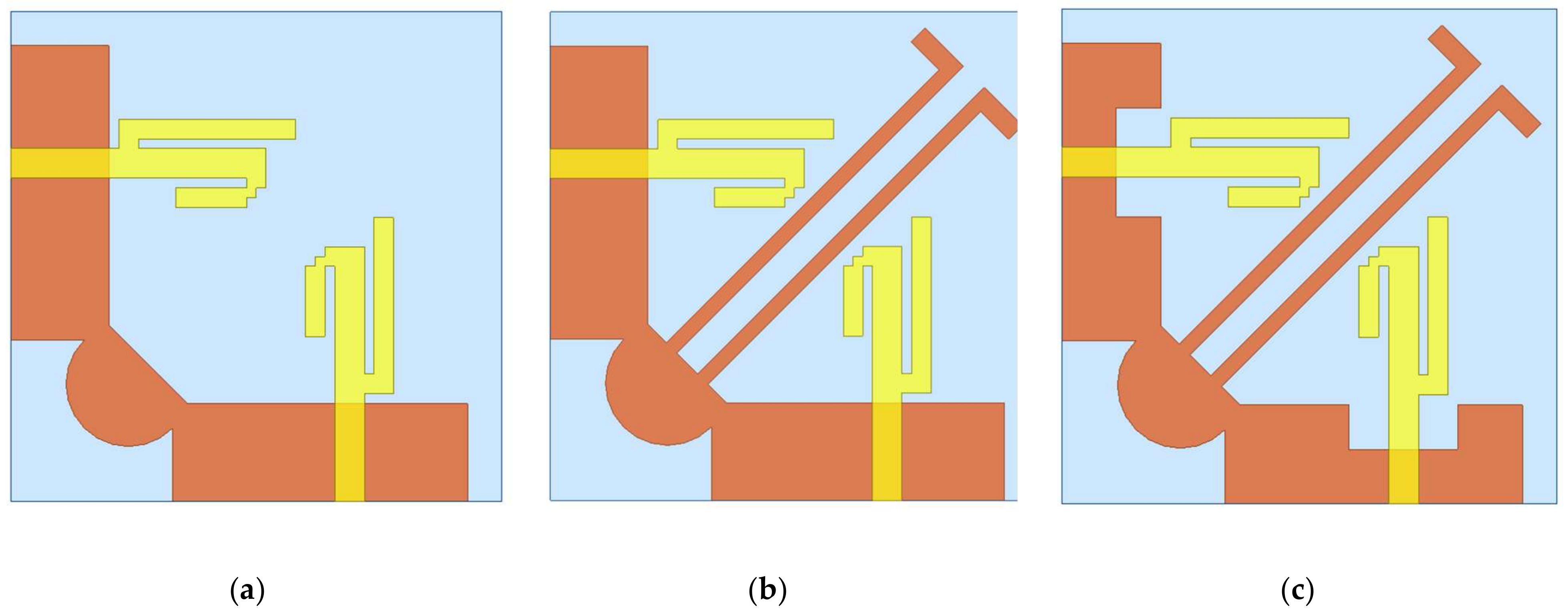



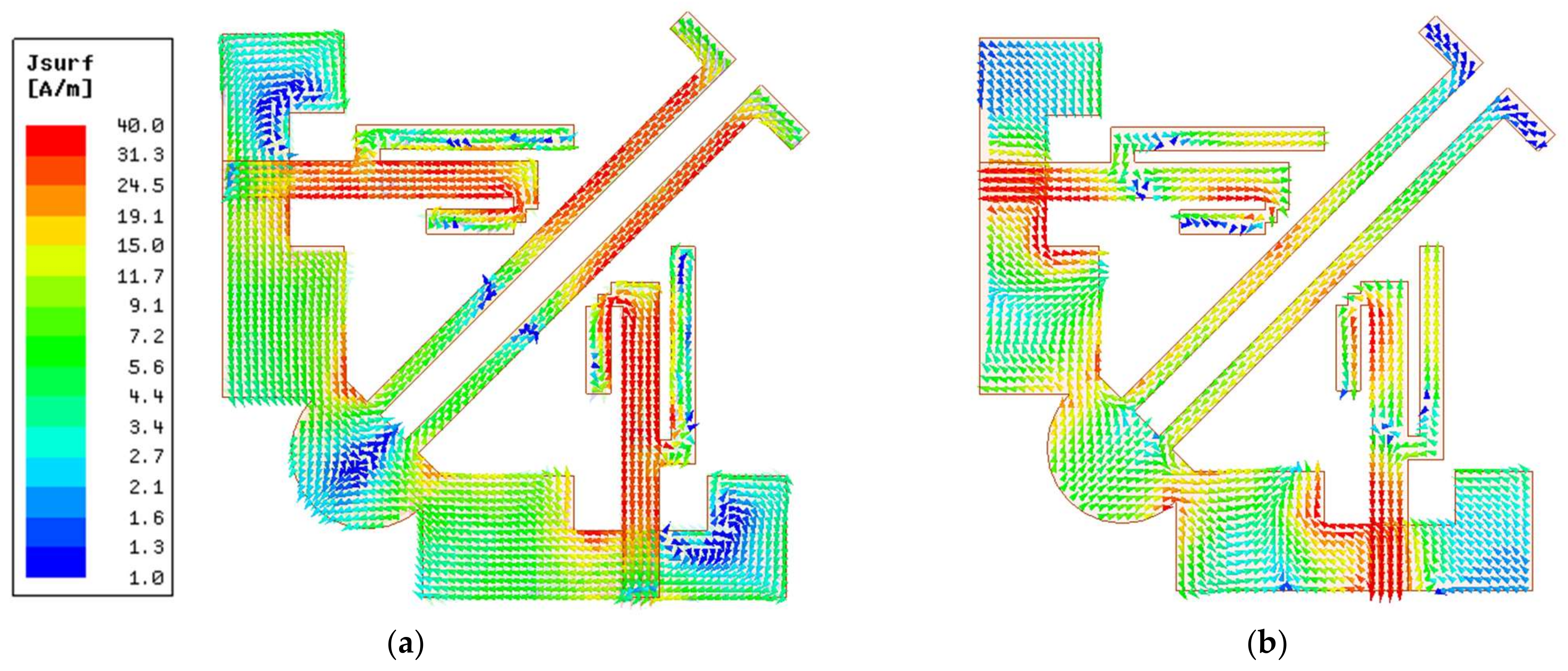

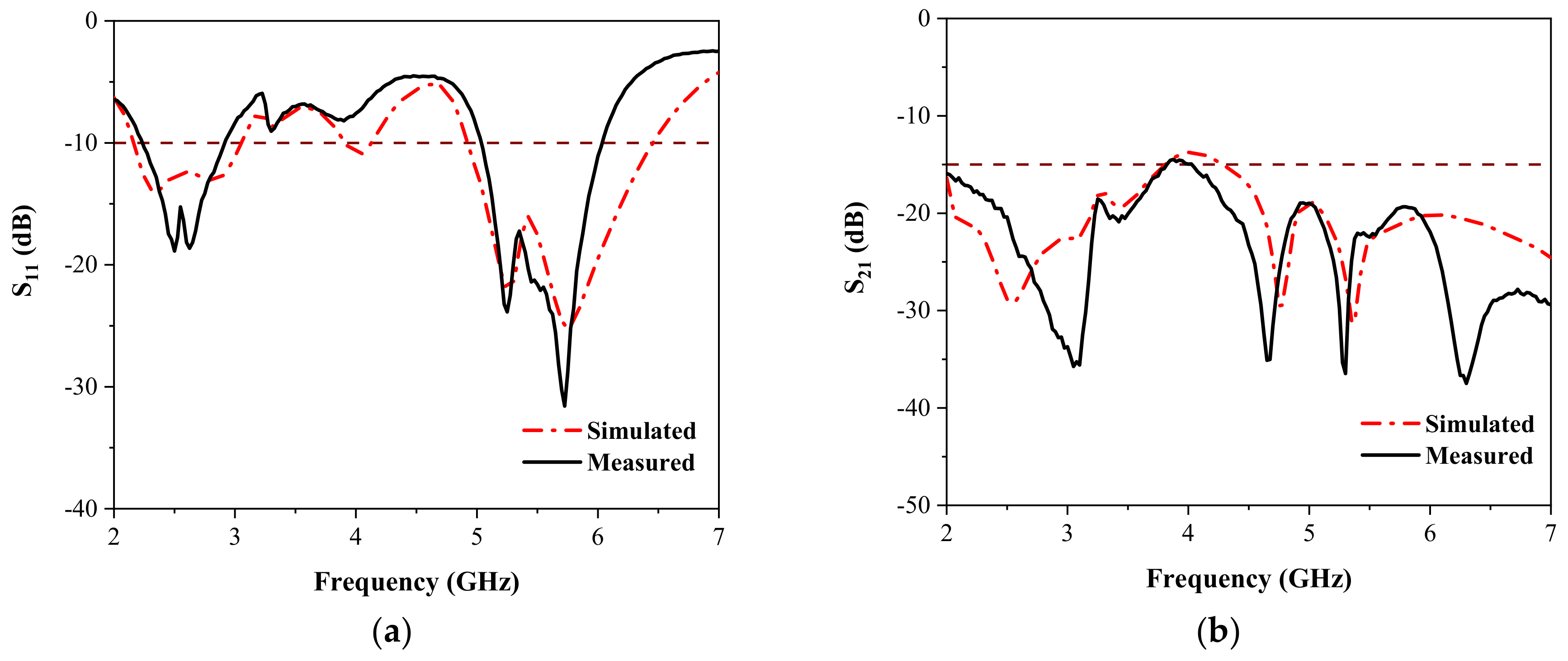
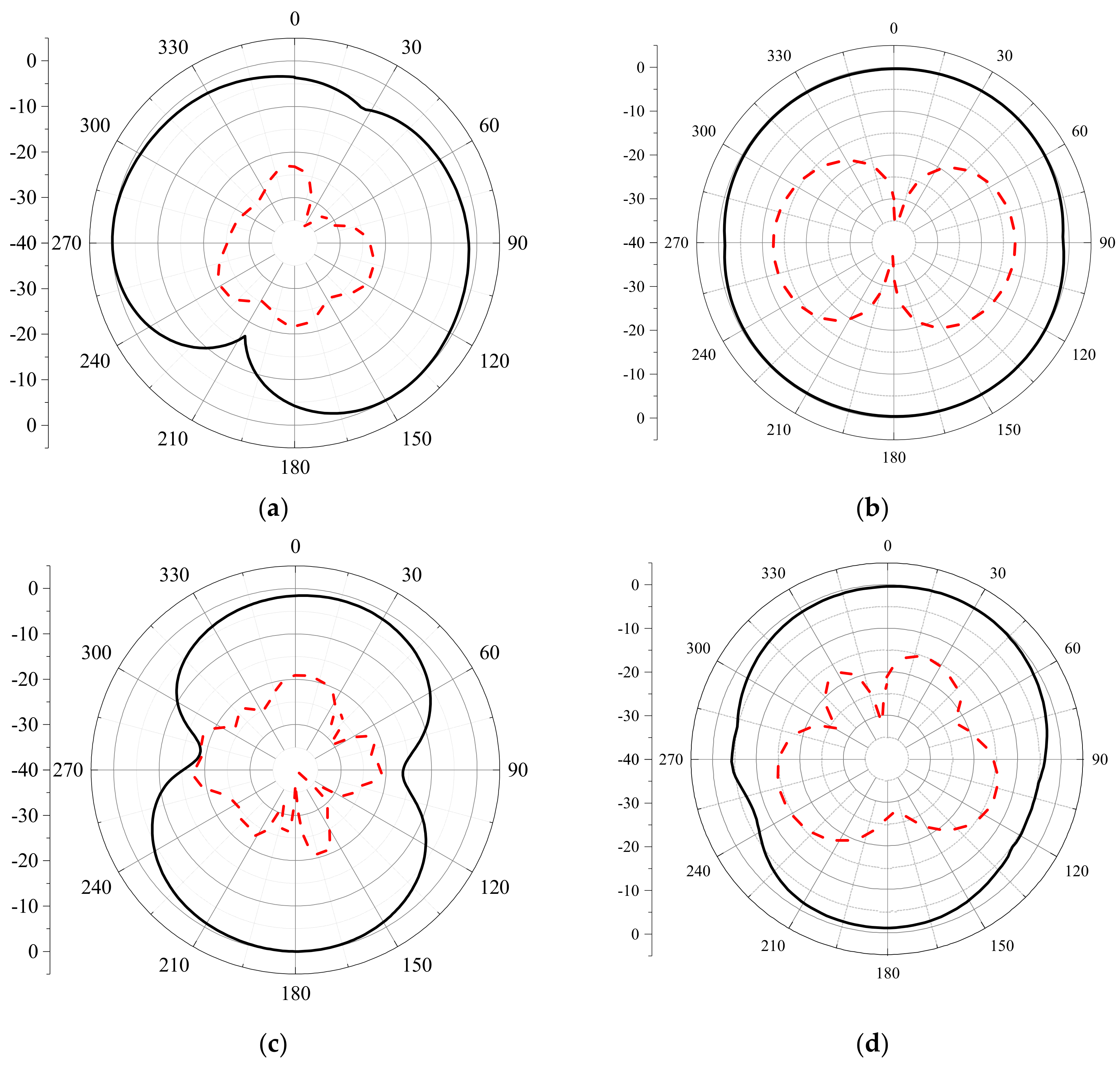
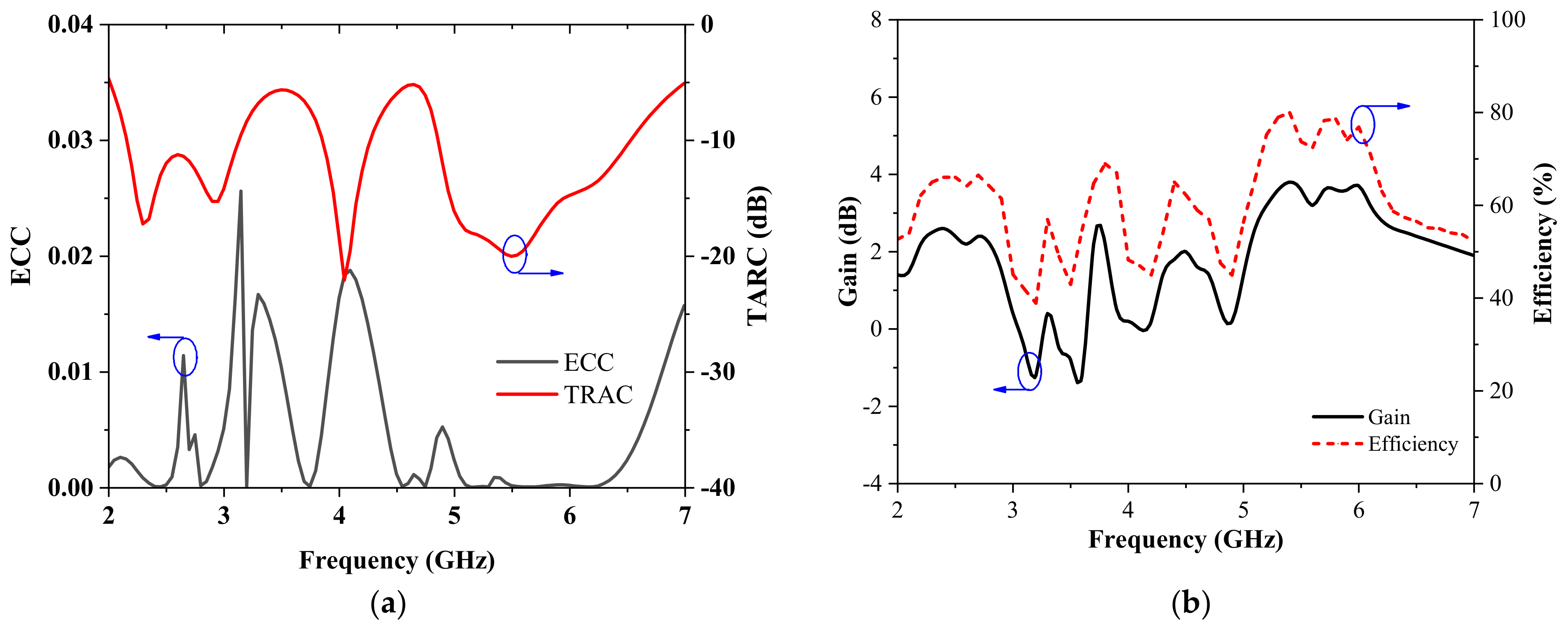
| Parameter | W1 | W2 | W3 | W4 | W5 | W6 |
| Value | 11 | 4.4 | 18 | 13 | 7.2 | 1 |
| Parameter | W7 | W8 | W9 | W10 | W11 | Ws |
| Value | 1 | 10 | 4.5 | 5.6 | 4.1 | 50 |
| Parameter | L1 | L2 | L3 | L4 | L5 | L6 |
| Value | 2 | 4 | 1 | 1 | 2 | 3 |
| Parameter | L7 | L8 | L9 | L10 | L11 | Ls |
| Value | 11 | 6.5 | 33.5 | 41.5 | 2 | 50 |
| Reference | Operating Bands (GHz) | Isolation (dB) | Peak Gain (dBi) | ECC | Size (mm3) |
|---|---|---|---|---|---|
| [14] | 2.4–2.5 4.9–5.8 | >14 | 2.5 | <0.27 | 46 × 20 × 1.6 |
| [15] | 2.25–2.41 4.7–6.25 | >18 | 2.96 | <0.2 | 48 × 48 × 1.6 |
| [16] | 2.3–2.5 5–5.2 | >20 | 2.01 | <0.05 | 38 × 19 × 1.6 |
| [17] | 2.28–2.7 4.96–6.1 | >15 | 2 | <0.06 | 46.5 × 46.5 × 1.6 |
| [18] | 2.4–2.48 5.15–5.83 | >15 | 3.1 | <0.2 | 77.5 × 52 × 1.6 |
| [19] | 2.1–2.8 5.0–5.7 | >20 | 3.2 | <0.01 | 74 × 47.3 × 1.6 |
| [20] | 2.4–2.5 5.1–5.8 | >15 | 3 | <0.1 | 19 × 23 × 1.6 |
| This work | 2.25–2.9 5.05–6.025 | >19.3 | 3.8 | <0.03 | 50 × 50 × 1.6 |
Publisher’s Note: MDPI stays neutral with regard to jurisdictional claims in published maps and institutional affiliations. |
© 2022 by the authors. Licensee MDPI, Basel, Switzerland. This article is an open access article distributed under the terms and conditions of the Creative Commons Attribution (CC BY) license (https://creativecommons.org/licenses/by/4.0/).
Share and Cite
Yang, Q.; Zhang, C.; Cai, Q.; Loh, T.H.; Liu, G. A MIMO Antenna with High Gain and Enhanced Isolation for WLAN Applications. Appl. Sci. 2022, 12, 2279. https://doi.org/10.3390/app12052279
Yang Q, Zhang C, Cai Q, Loh TH, Liu G. A MIMO Antenna with High Gain and Enhanced Isolation for WLAN Applications. Applied Sciences. 2022; 12(5):2279. https://doi.org/10.3390/app12052279
Chicago/Turabian StyleYang, Qichao, Chuanba Zhang, Qibo Cai, Tian Hong Loh, and Gui Liu. 2022. "A MIMO Antenna with High Gain and Enhanced Isolation for WLAN Applications" Applied Sciences 12, no. 5: 2279. https://doi.org/10.3390/app12052279






